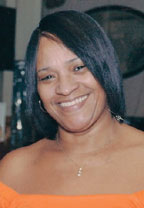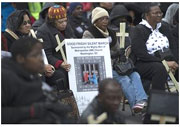

Autism often goes undetected in Black children
By Freddie Allen
WASHINGTON, D.C. (NNPA) – Areva Martin watched her youngest child play with growing concern. Marty was almost 18 months old and he didn’t play like other kids his age. Instead of racing toy cars on a track or across the floor, Marty would organize them in lines. He did the same thing with crayons. Instead of scribbling on paper or trying to color, he would just line them up. Marty played obsessively with random objects that he would find around the house: a house shoe, a cup, or a spoon would consume hours of play-time. But Martin, a lawyer living in Los Angeles, was most concerned about his speech.
“The first thing that came to my mind was, ‘This kid isn’t speaking, so let’s get him to a speech therapist,’” she said. After several months with a speech therapist, and no signs of improvement, Martin took her son to a developmental pediatrician. That’s when she learned that Marty was autistic.
“I knew very little about autism. I wasn’t even thinking about autism,” said Martin. “It wasn’t even a word in my vocabulary.”
Martin was devastated when she got the news, but then the lawyer in her kicked in. Martin needed to fix the problem to get her so a cure as soon as possible, but the mother of three quickly learned that there is no cure for autism and researchers are still working on what causes the developmental disorder.
The Centers for Disease Control and Prevention (CDC) defines autism spectral disorders (ASD) as “a group of developmental disabilities that can cause significant social, communication and behavioral challenges.”
Children with autism spectral disorders can progress normally then start losing skills or stop learning new ones. Other signs of ASD include delayed speech and language skills, flapping hands, or spinning in circles. Some toddlers won’t point at things or respond when their names are called.
CDC reported that 1 in 88 children were diagnosed with autism in 2008. According to a CDC study, one in 98 Black children were diagnosed with ASD compared to 1 in 83 white children. Between 2002 and 2008, Black children experienced a 91 percent increase in ASD diagnoses, compared to a 70 percent increase in ASD diagnoses for white children.
Researchers found that the increased rate of ASD diagnoses in children was in part related to increased awareness and changes in how ASDs are identified. Although the CDC found that more children are getting diagnosed before they reach 4 years of age, most are still diagnosed between 4 years of age and 5. Researchers have found that minority children are often diagnosed much later.
Marty was diagnosed at 2 years-old, but most Black children lag behind their peers when it comes to early intervention for ASDs.
Cultural differences can also have an impact on when and if minorities get the right treatment.
“There’s a hesitation in our community to talk openly about mental health issues and developmental disabilities and autism was no different,” said Martin.
“In some families there is a hierarchy of the decision-making. The grandmother of the child insists that the child is fine or the father insists that the child is fine,” said Rebecca Landa, director of the Center for Autism and Related Disorders at Kennedy Krieger Institute in Baltimore. “The mother in those situations is in a bit more of a complex family situation, politically, where she may be viewed as disrespectful if she says ‘I really do think something is wrong here.’”
Blacks and low-income families often lack access to adequate healthcare, which could delay an autism diagnosis. When Black children only see the doctor when they get sick, it’s harder for a physician to track a child’s progress.
Landa co-authored a 2012 paper, titled “Differences in Autism Symptoms between Minority and Non-Minority Toddlers,” based on her research. The paper reported that:
· “When minority children eventually diagnosed with ASD see health-care professionals, they are more likely to receive a diagnosis other than autism.”
· Black children who presented with signs of ASD, “were usually diagnosed with ADHD, conduct disorder, or adjustment disorder on their first specialty health-care visit.”
Alycia Halladay, senior director of environmental and clinical sciences for Autism Speaks, an autism science and advocacy group, said that children with autism from minority communities aren’t being recognized quickly enough.
“If these groups were traditionally underserved and not able to receive the same level of healthcare or awareness services that other people had, we felt like it was an obligation to ensure that there was equal access,” said Halladay.
Autism Speaks recently launched an advertising campaign, in an effort to increase awareness of autism in minority communities. Working with the Ad Council, Autism Speaks distributed advertising program kits and PSAs to more than 30,000 media outlets. Billboards and bus shelters featuring African American and Hispanic images and autism messages were also distributed nationwide. The ads and PSAs will run in donated space, so the advocacy group has almost zero control over when and where the ads will run or if they will run at all. According to the group, a similar campaign geared towards a general audience was successful with increasing awareness about autism.
Martin said that she’s glad to see that Autism Speaks launched the campaign for minorities, but she wonders if the ads will hit their target.
Shortly after her son’s diagnosis, Martin discovered a lack of access to resources and education for children and parents living with autism tailored to fit the needs of low-income and minority communities. In 2005, she founded the Special Needs Network to fill that void.
“I work at a grassroots level and reaching our community is a lot of work,” said Martin. “Where we get our news and where we get our information is often very different and a lot of times organizations miss the mark.”
Martin continued: “Are those ads going to be in Black newspapers that are handed out in Black churches or on radio stations in Black markets? Are the ads going to come on while people are watching ‘Love and Hip Hop Atlanta?”
“An ad running in the mainstream media on a major network at a certain time of day just isn’t going to reach Black and Latino families,” said Martin.
“What we need to do now is empower parents to be their child’s advocate to let them know where to go for information and how to find the navigators in their community,” said Landa.
As one of those navigators, Martin knows that autism awareness often competes with myriad issues affecting poor and minority families.
“Autism is only one issue. When you’re serving low-income and underserved communities they’re dealing with transportation, housing, employment so, many other issues,” said Martin. “Autism just becomes one of a lot of issues that a family is dealing with. It has to be a very coordinated strategy to reach that family and get to that child.”
Martin continued: “For many parents, when they get the diagnosis they feel that in some ways it’s a death sentence. It’s not, there’s hope.”





Be the first to comment